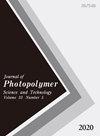Fabrication of Colloidal Crystal Gel Film Using Poly(N-vinylcaprolactam)
IF 0.7
4区 化学
Q4 POLYMER SCIENCE
Journal of Photopolymer Science and Technology
Pub Date : 2021-06-11
DOI:10.2494/photopolymer.34.543
引用次数: 2
Abstract
In this report, we successfully fabricated the colloidal crystal (CC) gel films of silica microparticles combined with a temperature-responsive biocompatible hydrogel of poly(Nvinylcaprolactam) (VCL). When the CC VCL film was prepared by filling VCL precursor into the void space between silica particles of CC film, followed by the thermal polymerization, the Bragg reflection peak was red-shifted from 475 nm to 535 nm due to the change of refractive index contrast. Subsequently, immersion of the CC VCL film into an excess of water led to the formation of CC VCL gel film, wherein the VCL matrix swelled in water to form the hydrogel state. As elevating the temperature from 25 °C, this CC VCL gel film showed the reflection color changes from red to green, arising from the decrease of lattice constant induced by the shrinkage of VCL hydrogel. Moreover, the reflection color changes of CC VCL gel film were found to be fully reversible. In this way, we believe that such CC VCL gel films can be potentially applied to novel temperature sensors with biocompatibility.聚n -乙烯基己内酰胺制备胶体晶体凝胶膜
在本报告中,我们成功地制备了二氧化硅微颗粒的胶体晶体(CC)凝胶膜,并结合了温度响应的生物相容性聚乙烯基己内酰胺(VCL)水凝胶。将VCL前驱体填充到CC膜二氧化硅颗粒之间的空隙中,然后进行热聚合制备CC VCL膜,由于折射率对比的变化,Bragg反射峰从475 nm红移到535 nm。随后,将CC VCL膜浸入过量的水中,形成CC VCL凝胶膜,其中VCL基质在水中膨胀形成水凝胶状态。当温度从25℃升高时,该CC VCL凝胶膜的反射颜色由红色变为绿色,这是由于VCL水凝胶收缩导致晶格常数降低所致。此外,发现CC VCL凝胶膜的反射颜色变化是完全可逆的。通过这种方式,我们相信这种CC VCL凝胶膜可以潜在地应用于具有生物相容性的新型温度传感器。
本文章由计算机程序翻译,如有差异,请以英文原文为准。
求助全文
约1分钟内获得全文
求助全文
来源期刊
CiteScore
1.50
自引率
25.00%
发文量
0
审稿时长
4-8 weeks
期刊介绍:
Journal of Photopolymer Science and Technology is devoted to the publication of articles on the scientific progress and the technical development of photopolymers.

 求助内容:
求助内容: 应助结果提醒方式:
应助结果提醒方式:


